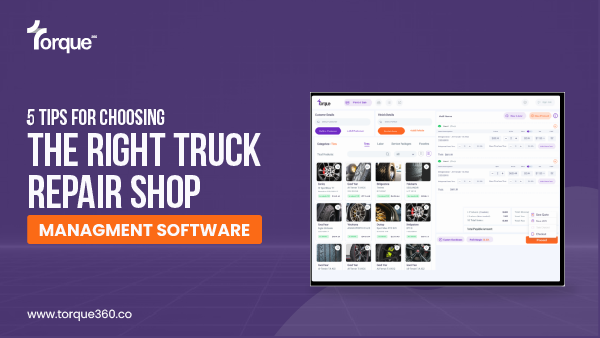Big rigs or tractor-trailers are other names for semi-trucks. These are essential to the transportation industry for moving freight across large distances in an efficient manner.
We’ll discuss the types, parts, and importance of semi-truck shop software in preserving efficiency as we examine the essential characteristics of semi-trucks and trailers here.
Synopsis of Semi-Trailers
Semi-trucks are made up of one or more trailers and a tractor unit. Cargo is transported via trailer, but the tractor unit houses the driver’s cabin and engine.
For a variety of sectors, this arrangement enables flexible loading and unloading.
In the United States, there are about 2.9 million semi-trucks in use.
Semi-trucks collectively cover around 140 billion miles each year, with long-haul trucks traveling over 100,000 miles annually.
Key Components of Semi-Trucks
Understanding the essential parts of a semi-truck is crucial for effective maintenance and operation. Key components include:
- Engine and transmission
- Chassis and frame
- Cab and sleeper
- Axles and suspension
- Wheels and tires
Types of Semi-Truck Trailers
Trailers are vital in determining the kind of cargo a semi-truck can transport. There are several types of trailers, each designed for specific hauling needs.
Flatbed Trailers
Flatbed trailers are highly versatile and commonly used for transporting goods that do not require enclosure.
- Dimensions: Standard lengths are 48 to 53 feet.
- Uses: Ideal for construction materials, machinery, and large equipment.
Key Features
- Sturdy metal frame
- Wide, flat deck
- Adjustable winches
- Side stake pockets
- Ramp attachments
Enclosed Trailers (Dry Vans)
Enclosed trailers, known as dry vans, are among the most frequently used trailer types.
- Dimensions: Typically range from 28 to 53 feet in length.
- Uses: Transport goods that need protection from weather and theft, including electronics, furniture, and perishables.
Key Features
- Durable outer walls
- Reinforced flooring system
- Secure locking mechanisms
- Weather-resistant roofing
- Interior tie-down points
Specialized Trailers
Certain goods require specialized trailers to ensure safe and efficient transportation.
Refrigerated Trailers (Reefers)
Refrigerated trailers maintain temperature-controlled environments, which are essential for transporting perishable goods.
- Capacity: Can carry up to 45,000 lbs of goods.
- Uses: Transporting food, pharmaceuticals, and other perishable items.
Tanker Trailers
Tanker trailers are designed to carry liquids, gasses, and bulk materials.
- Capacity: Varies, with some capable of carrying up to 9,000 gallons.
- Uses: Transporting fuel, chemicals, and food-grade liquids.
Semi-Truck Shop Software’s Significance
Effectiveness in the Management
Repair shop software streamlines fleet management by automating maintenance schedules, tracking vehicle repairs, and managing parts inventory, reducing downtime and improving operational efficiency.
Savings on Costs
Truck repair software is not just a tool for fleet management; it’s a smart investment that avoids expensive malfunctions and streamlines maintenance plans.
However, It helps reduce overall maintenance costs and extends the lifespan of vehicles, leading to significant financial savings in the long run.
Enhanced Compliance
The software ensures compliance with industry regulations by maintaining detailed records of inspections, repairs, and maintenance activities, helping avoid fines and legal issues.
Streamlined Communication
It facilitates better communication between drivers, technicians, and management by providing a centralized platform for reporting issues, scheduling repairs, and tracking maintenance progress.
Performance Analytics
Semi-truck shop software provides detailed analytics and reports on vehicle performance, maintenance costs, and shop efficiency, enabling data-driven decision-making.
Time Management
Automating routine tasks and scheduling helps save time for technicians and shop managers, allowing them to focus on more critical tasks and improving overall productivity.
Customer Service Improvement
The software can improve customer satisfaction for shops servicing external fleets by providing timely updates, accurate repair estimates, and better overall service quality.
Scalability
As a business grows, semi-truck shop software can quickly scale to accommodate more vehicles, technicians, and shop locations, ensuring that operations remain efficient and organized.
Maintenance and Safety
Regular maintenance is crucial for the safe and efficient operation of semi-trucks and trailers.
Routine Maintenance
Routine checks and servicing can prevent breakdowns and extend the lifespan of the vehicle.
Regular inspections of brakes, tires, and engine components.
Checking and maintaining appropriate oil, coolant levels, and other fluids.
Safety Measures
It is critical for semi-truck drivers to prioritize road safety.
- Driver Training: Comprehensive training programs for drivers.
- Safety Equipment: Installation of safety devices such as airbags, anti-lock braking systems, and stability control.
Economic Impact of Semi-Trucks
Semi-trucks are indispensable to the economy, transporting the majority of goods across the country.
Contribution to the Economy
- Goods Transportation:
Semi-trucks transport 68% of all goods in the U.S, equating to about 60,000 lbs per person annually.
- Industry Employment:
The trucking industry employs millions of drivers, mechanics, and support staff.
Environmental Considerations
- Fuel Efficiency:
Advances in technology have improved the fuel efficiency of semi-trucks.
- Emissions Reduction:
Regulations and innovations aim to reduce the carbon footprint of these vehicles.
Future Trends in Semi-Trucks
The trucking industry continuously evolves, with new technologies and trends shaping its future.
Autonomous Trucks
Autonomous driving technology is gradually being integrated into semi-trucks, promising to revolutionize the industry.
- Benefits: Increased safety, reduced labor costs, and improved efficiency.
- Challenges: Regulatory hurdles and the need for robust infrastructure.
Electric Semi-Trucks
Electric trucks are emerging as a sustainable alternative to traditional diesel-powered vehicles.
- Advantages: Lower emissions, reduced fuel costs, and quieter operation.
- Barriers: High initial costs and limited charging infrastructure.
Wrapping Up!
Semi-trucks and trailers are the backbone of the transportation industry, playing a critical role in the economy by moving goods efficiently across the country. Understanding their types, components, and maintenance needs is essential for anyone in the trucking business. Integrating semi-truck shop software has further enhanced the management and operation of these vehicles, ensuring they remain a reliable mode of transportation. As technology advances, the future of semi-trucks looks promising, with innovations like autonomous driving and electric vehicles paving the way for a more efficient and sustainable industry.



